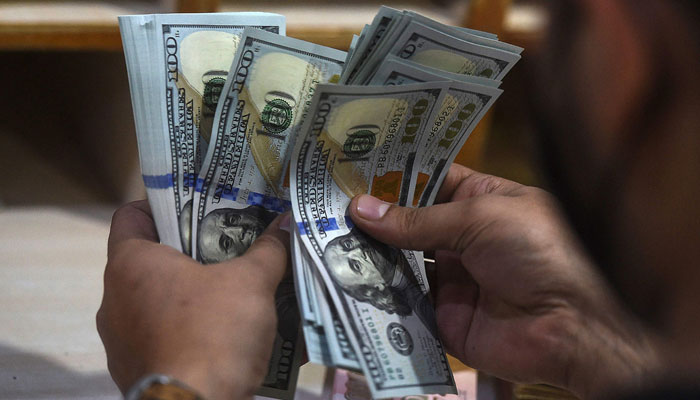$2.5bn remittances in Oct as legal inflows rise
KARACHI: Remittances rose to a seven-month high at $2.5 billion in October as the migrant workers sent more funds home through legal banking channels.
According to the figures issued on Friday by the central bank, the amount of money that Pakistani workers employed abroad sent home climbed by 12 percent in October on a month-on-month basis.
The previous month had $2.2 billion in inflows. October saw a 10 percent year-on-year increase in remittances. However, in the first four months of the current fiscal year, these flows decreased by 13 percent to $8.8 billion.
The latest remittances data came when the IMF mission began reviewing Pakistan’s $3 billion loan programme last week. It is expected that the review will last until December 15.
In December, Pakistan will get the second tranche of $700 million if the Fund’s assessment of the nation’s economy and the targets set for the first quarters prove successful.
Pakistan received $1.2 billion in July from the IMF as the first installment of $3 billion standby arrangement (SBA).
Saudi Arabia was the source of the largest remittance inflows for Pakistan, amounting to $616.8 million in October, up 6 percent YoY and 15 percent MoM. After that, Pakistan received $473.9 million from the United Arab Emirates, an increase of 11 percent from a year ago and 19 percent from the month prior.
In October, remittances from the UK increased by 18 percent to $330.2 million. The MoM increase in these inflows was 6 percent.
October saw an 8 percent increase in remittances from the United States of America, totaling $283.3 million. There was a 7 percent MoM increase in these inflows.
Analysts had generally anticipated an improvement in the remittances. The September crackdown on illicit foreign exchange activity in the grey and black markets sharply reduced the huge currency rate gap between the interbank market and the grey market, encouraging several Pakistani expats to send money home through official channels.
The crackdown, along with other administrative measures taken by the government and the central bank, strengthened the Pakistani rupee. In September and October, the rupee gained almost 11 percent against the dollar.
The head of research at Arif Habib Limited, Tahir Abbas, reported that remittances in October were at their highest level since March 2023.
“With the convergence of interbank and open market rates alongside a crackdown on illegal channels, including hawala/hundi, the remittances showed an encouraging trend and witnessed an increase of 10 percent YoY and 12 percent MoM in October.
Between July and October of FY2024, Pakistan’s remittance inflows fell.
Three or four months ago, the remittances were trending downward for several low and middle-income countries. Because migrant workers found it more advantageous to transfer money through illegal non-banking channels given that currency prices in the grey market, also known as hawala, were higher than official exchange rates, not only did Pakistan but other countries in the region, notably Bangladesh, also saw a decline in migrant worker inflows.
The decline in remittances was caused by a number of factors, including a slowdown in economic activity in the advanced economies of the US, Europe, and the GCC, which are Pakistan’s main sources of remittances. Other factors included volatile global oil prices and fluctuating currency exchange rates in these countries.
Remittance growth combined with a closing trade deficit is encouraging for Pakistan’s balance of payments.
The country’s trade gap fell 38 percent MoM to $2.09 billion in October. “We expect remittances for FY24 to cross the $30 billion mark. The uptick in remittances will support the balance of payments,” said Mustafa Mustansir, the head of research at Taurus Securities.
-
 Princess Beatrice, Eugenie Resort To Begging Sarah Ferguson: 'It'll Bring Disaster For The Whole Family'
Princess Beatrice, Eugenie Resort To Begging Sarah Ferguson: 'It'll Bring Disaster For The Whole Family' -
 Jenny Slate Hails Blake Lively Amid Lawsuit Against Justin Baldoni
Jenny Slate Hails Blake Lively Amid Lawsuit Against Justin Baldoni -
 Sophie Wessex Shares 'frustration' From Early Days In Royal Family
Sophie Wessex Shares 'frustration' From Early Days In Royal Family -
 Jason Momoa's Aquaman Unseen Snap Revealed
Jason Momoa's Aquaman Unseen Snap Revealed -
 Prince Harry Taught Only Way King Charles 'will Take Him Seriously'
Prince Harry Taught Only Way King Charles 'will Take Him Seriously' -
 Meghan Markle’s Reaction To UK Talks With Prince Harry Comes To The Forefront: ‘Leaving Me?’
Meghan Markle’s Reaction To UK Talks With Prince Harry Comes To The Forefront: ‘Leaving Me?’ -
 Taylor Swift Slams Justin Baldoni In Explosive Text Messages, Court Filing Reveals
Taylor Swift Slams Justin Baldoni In Explosive Text Messages, Court Filing Reveals -
 Blake Lively’s Drops New Allegations Against Justin Boldoni About Birth Scene
Blake Lively’s Drops New Allegations Against Justin Boldoni About Birth Scene -
 Andrew's Reasons For Giving Sarah Ferguson A Rent-free Home For 30 Years After Divorce Finally Finds An Answer
Andrew's Reasons For Giving Sarah Ferguson A Rent-free Home For 30 Years After Divorce Finally Finds An Answer -
 Charlie Puth Reveals Wake-up Moment That Made Him Quit Alcohol
Charlie Puth Reveals Wake-up Moment That Made Him Quit Alcohol -
 Meghan Trainor Welcomes Baby Girl Mikey Moon Trainor And Turns Emotional
Meghan Trainor Welcomes Baby Girl Mikey Moon Trainor And Turns Emotional -
 Meghan Markle Would Not 'hide Away' From UK For Harry's Sake
Meghan Markle Would Not 'hide Away' From UK For Harry's Sake -
 Why Keith Urban's Daughters Are Avoiding His Rumored Girlfriend? Source
Why Keith Urban's Daughters Are Avoiding His Rumored Girlfriend? Source -
 Sarah Ferguson Led Andrew To Jeffrey Epstein: ‘She Wanted Him To Ask For More Money’
Sarah Ferguson Led Andrew To Jeffrey Epstein: ‘She Wanted Him To Ask For More Money’ -
 Blake Lively Claimed Justin Baldoni 'made A Monster' Of Her, Court Docs Reveal
Blake Lively Claimed Justin Baldoni 'made A Monster' Of Her, Court Docs Reveal -
 Prince William Accused Of 'harsh Decisions' Over Disgraced Royal
Prince William Accused Of 'harsh Decisions' Over Disgraced Royal




